Primary Type of Art Medium for Raphael the Artist
Since Classical Artifact, Fresco painting has been a popular fine art form. The early and late Renaissance period saw an incredible insurgence in fresco painting techniques with works like Michelangelo's Sistine Chapel ceiling. The fresco manner of painting is most suited to large-scale wall pieces, celebrated as i of the most incredible mural-making techniques in art history.
Table of Contents
- 1 What Is a Fresco?
- 2 Different Fresco Painting Techniques
- ii.1 Buon Fresco Painting Techniques
- ii.2 Secco Fresco Painting Techniques
- ii.3 Mezzo Fresco Painting Techniques
- iii The Long and Colorful History of Fresco Painting
- three.1 The Starting time Fresco Paintings
- 3.two Frescos From Classical Artifact
- 3.three The Rebirth of Renaissance Frescos
- 3.4 An English Fresco Revival
- 3.5 Fresco Painting Today
- 4 Famous Frescos From Antiquity and Modernity
- 4.1 1600-1450 BCE: Bull-Leaping Fresco
- iv.ii 500-400 BCE: Sigiriya Rock Frescos
- 4.3 55-79 CE: Sappho Fresco
- four.iv 1442-1443 CE: The Annunciation
- iv.v 1495-1496: The Concluding Supper
- 4.six 1508-1512: The Sistine Chapel Ceiling
- iv.vii 1511: The School of Athens
- five Recommended Reading for Fresco Fanatics
- 5.1 Florence: The Paintings & Frescoes, 1250-1743
- 5.2 Italian Frescoes: High Renaissance and Mannerism 1510-1600
What Is a Fresco?
Many consider fresco and mural painting to exist i and the aforementioned, but this is not quite true. While virtually all fresco paintings are murals or large-scale paintings on walls or ceilings, murals are not necessarily frescos. The fresco fine art definition is slightly dissimilar from that of murals.
And then, what is a fresco? The proper name fresco,or "fresh" in Italian, stems from the practice of painting with a mix of water and pigment onto freshly laid wall plaster. As the lime-based plaster dries in the air, carbonation fuses the pigment particles inside the plaster. As such, the fresco painting technique actually increases the integrity of the wall and the painted epitome.
The celebrity of fresco painting lies in its longevity. Fresco paintings out-survive almost every other medium. Many fresco paintings from Ancient Hellenic republic, Rome, India, Sri Lanka, and Egypt remain in relatively good condition today. Some contemporary mural artists keep to use fresco techniques considering of the superior weather immovability.
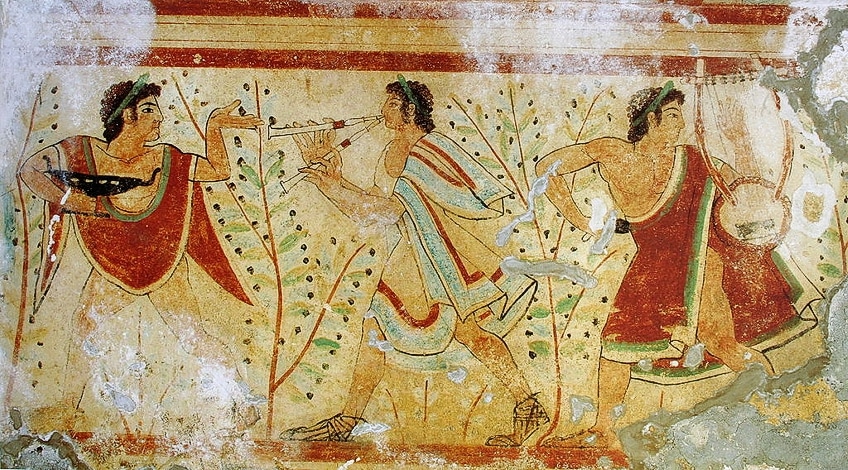 5th century BC fresco of dancers and musicians, Tomb of the Leopards, Monterozzi necropolis, Tarquinia, Italian republic; Unknown Writer, Public domain, via Wikimedia Eatables
5th century BC fresco of dancers and musicians, Tomb of the Leopards, Monterozzi necropolis, Tarquinia, Italian republic; Unknown Writer, Public domain, via Wikimedia Eatables
Different Fresco Painting Techniques
At that place is no one fresco art definition. At that place are three unlike types of fresco painting with differing methods of adhering pigment to the wall plaster. Buonor "true" fresco artists paint with a pigment-water mixture directly onto the freshly applied lime plaster. Southecco fresco painting uses pigment mixed with a binder on a dry out plaster sheet. Finally, the mezzo fresco painting is somewhere in the centre of the previous two. Artists creating mezzo frescos pigment on plaster that is about dry out.
Buon Fresco Painting Techniques
Buon fresco painting is the oldest, nigh durable, and most mutual type of fresco. The paint mixture is a combination of pigment and room temperature water. The sail for Buon fresco painting is a very thin layer of wet plaster, called the intonaco. The intonaco itself binds the pigment to the wall, so in that location is no need to use a binder.
The intonaco tends to dry within a few hours and cannot exist fixed by simply painting over it, so artists need to work speedily and accurately with buon fresco. There are three full general steps that buon fresco artists demand to follow so as to ensure the integrity of their painting.
The first step in painting buon fresco is the awarding of a crude underlayer known as the arriccio. The arriccio layer is typically a mixture of sand, marble dust, and plaster. The artist applies this underlayer to the entire portion of the wall to be painted and leaves it to dry for a few days. The number of layers of arriccio in buon frescos varies by creative person and period, but it can be up to three.
Once the arriccio layer has stale, the artist can transfer the sketch of their composition onto the wall. Many early artists used sinopia, a reddish pigment, to outline the plan for the fresco. Other, more mod techniques include placing a newspaper cartoon onto the wall and pricking over the chief lines with a point, and finally pressing a handbag of soot over the paper to reveal the dotted lines.
On the solar day of painting, the artist trowels the smoother intonaco plaster onto the wall area, which they could finish in a mean solar day. The name for this "day's work" portion of the wall is giornata. Y'all can typically come across a faint seam separating the dissimilar giornatas on very large frescos. Sometimes, artists would plan the giornatas by figures within the composition, but typically, most artists start at the top.
Perchance the virtually significant restriction when using buon fresco techniques is the rapid drying time of the intonaco plaster layer. Typically, the layer of plaster will have between x and twelve hours to dry out completely. Traditionally, buon fresco artists will simply begin painting around two hours after applying the intonaco, and volition finish 2 hours before the concluding drying time.
Later the giornata plaster has dried fully, the artist cannot continue to paint and must remove any unpainted intonaco. The carbonation of the lime plaster as it air-dries is an essential role of the buon fresco process.
Secco Fresco Painting Techniques
Fresco secco techniques completely eradicate the time-pressures of buon frescos. The sheet for seccofrescos is a stale plaster wall, and the pigment contains the color pigment and a folder similar tempura egg yolk, oil, or gum. While secco fresco painting does away with the faff of preparing the plaster and the need to work at speed, it does sacrifice durability.
Artists often used fresco secco techniques to fix or add to buon frescos. Blue pigments, for instance, were difficult to achieve using buon fresco considering of the plasters alkalinity. Information technology is becoming increasingly obvious that many early Renaissance painters used secco techniques because of the broader range of colors available.
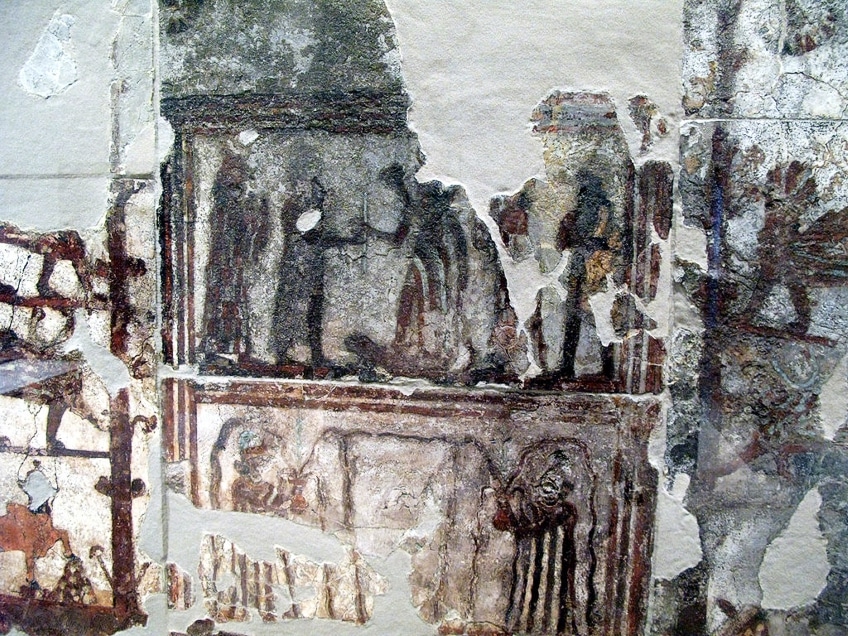 Fresco of the investiture of Zimri Lim, 19th century BC, Royal palace of Mari; Louvre Museum, CC BY-SA 2.0 FR, via Wikimedia Commons
Fresco of the investiture of Zimri Lim, 19th century BC, Royal palace of Mari; Louvre Museum, CC BY-SA 2.0 FR, via Wikimedia Commons
While buon fresco painting requires a smooth intonaco surface, secco fresco techniques work best on a roughened plaster surface. The crude surface increases the durability of secco, but these frescos are more vulnerable to dampness than buon techniques. For totally secco frescos, the intonaco has a roughed finish and is left to dry thoroughly. The surface is then fabricated rougher still past rubbing it with sand. The artist can paint the intonaco surface in much the same manner they would a wooden console or a traditional canvas.
Not just is the process of secco painting faster, but artists can also right mistakes with more than ease. Additionally, the deviation in color between the wet pigment and the final composition is not as pregnant as buon fresco techniques. Raphael and Michelangelo frequently used secco techniques in their frescos, and the artists ofttimes created indentations on the plaster surface to create more depth.
Mezzo Fresco Painting Techniques
The concluding form of fresco painting is the mezzo technique. The mezzo fresco technique is a combination of the buon and secco styles. Artists paint on intonaco that is almost but non quite dry, and so the pigment absorbs only slightly into the plaster. This fresco technique became increasingly popular during the early on Renaissance and had almost replaced buon techniques entirely by the beginning of the 17th century.
There are several advantages to using mezzo fresco techniques, with the foremost being extending painting time. The extension of painting time has the boosted advantage of assuasive artists to complete larger fresco areas in a single sitting. Landscape paintings, in particular, benefited from the mezzo techniques as the distinctions between buon giornatas would ruin the continuity of the composition. Mezzo fresco techniques were popular amongst many tardily Baroque artists, including Gianbattista Tiepolo.
The Long and Colorful History of Fresco Painting
While fresco painting techniques came into their ain during the Italian Renaissance, the earliest examples date back to Classical Antiquity. Additionally, while many people tend to view fresco paintings as traditional western, the techniques have historically been used throughout the globe. We begin our exploration of the history of fresco painting in Arab republic of egypt and end by considering some contemporary fresco styles.
The Offset Fresco Paintings
Every bit far equally we know, the earliest fresco examples found in the Hierakonpolis tomb in Egypt date back to betwixt 3500 and 3200 BCE. Other early on frescos in Israel, Egypt, and Crete date back to 2000 BCE. These frescos typically adorn the walls of tombs and palaces and depict various parts of aboriginal life, including battles and farming. The Investiture of Zimri-Lim is one fantastic fresco instance from 18th century BCE Mesopotamia. These earlier tomb frescos, particularly the ones in Egypt, use the secco fresco technique.
In terms of buon fresco techniques, the oldest frescos date to the Aegean civilizations in the beginning half of 2000 BCE. The Toreador is perhaps the virtually famous early buon fresco and depicts men jumping over large bulls equally role of a sacred anniversary. Many of the oldest buon frescos, dated to the Neo-Palatial era, are found on Santorini, a Greek isle. Other similarly dated frescos in Morocco and Arab republic of egypt are under speculation in terms of their origins. Some art historians believe that many of them may have reached these shores through trade from Crete.
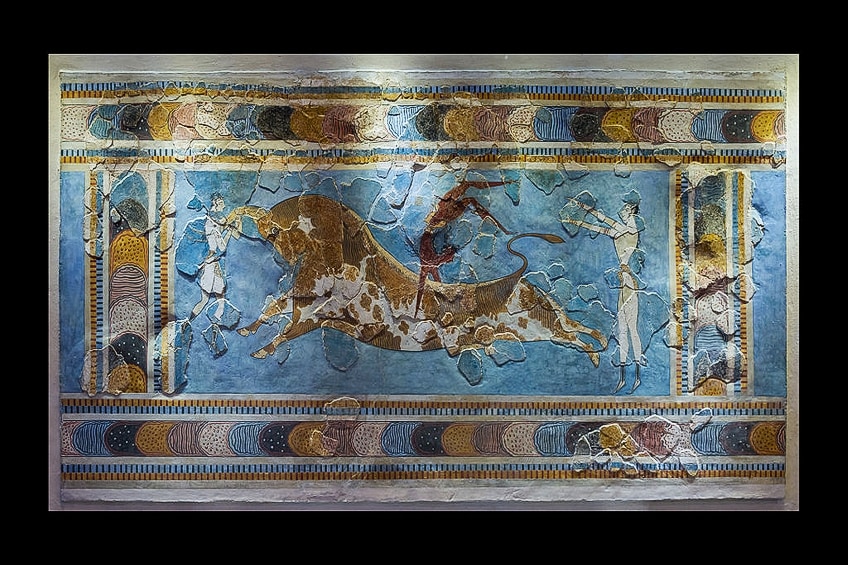 Toreador Fresco (Balderdash-Leaping Fresco)(c. 1550/1450 BC); Heraklion Archaeological Museum, CC0, via Wikimedia Commons
Toreador Fresco (Balderdash-Leaping Fresco)(c. 1550/1450 BC); Heraklion Archaeological Museum, CC0, via Wikimedia Commons
Frescos From Classical Antiquity
Many artists from the Ancient Greek period painted frescos, but unfortunately, very few remain today. A Magna Graecia tomb, known as the Tomb of the Diver, found in southern Italy in 1968, contains Aboriginal Greek frescos dated to 470 BCE. These Frescos present social and everyday life scenes from Ancient Hellenic republic. One fresco, for case, depicts a fellow diving into the ocean. Another fresco in the same tomb shows a collection of men resting at the symposium. The Tomb of Orcus in Italia includes other frescos from the Etruscan era.
The buon frescos institute in the ruins of Herculaneum and Pompeii demonstrate the Roman fashion of fresco painting. In the catacombs beneath Rome, there are examples of tardily Roman Empire frescos. Other Roman frescos depicting Byzantine icons exist in Antioch, Crete, Cappadocia, and Republic of cyprus.
While Classical Antiquity typically refers to Aboriginal Rome and Greece, this period as well saw fresco paintings in Sri Lanka and India. In that location are over 20 different locations in Bharat with preserved frescos dated between 200 and 400 BCE. Many of these frescos beautify the ceilings and walls of rock-cut cave temples similar those in the Ajanta Caves. The frescos in this cave are the oldest in Republic of india and depict the Buddha's life.
In Sri Lanka, the Sigiriya frescos date to the reign of Rex Kashyapa around 500 Advertizement. Most art historians believe that these frescos depict the women of the rex'southward court. The style of these frescos is similar to the Gupta painting style establish in the Ajanta Caves. The Sigiriya frescos use a fresco lustro technique that uses a small corporeality of glue or binding agent.
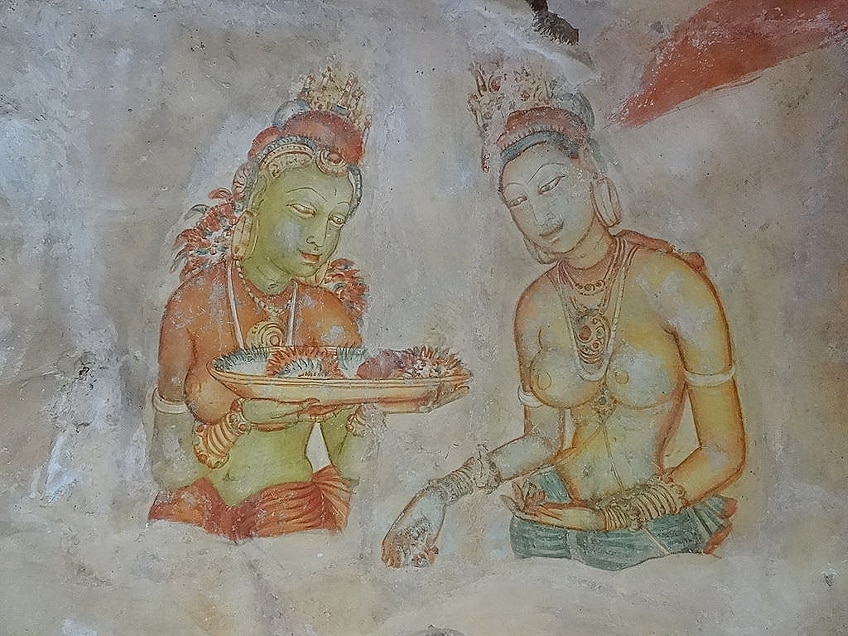 Sigiriya frescos, c. 500 AD; Cherubino, CC BY-SA 3.0, via Wikimedia Commons
Sigiriya frescos, c. 500 AD; Cherubino, CC BY-SA 3.0, via Wikimedia Commons
The Rebirth of Renaissance Frescos
It was in the hands of Italian Renaissance painters that fresco actually came into its ain. Many art historians consider the Italian Renaissance to be the elevation of fresco painting, and many of the almost exquisite frescos from this menstruum remain in stunning status today. Many Renaissance frescos adorn the walls and ceilings of private, public, and religious buildings. These frescos often draw biblical scenes or the stories of saints.
The Renaissance menstruation saw an explosion of experimentation with fresco techniques. Renaissance frescos tend to accept lavish ornamentation, and some contain gold foliage, like Scrovegni Chapel past Giotto di Bondone in 1305. Many artists like Michelangelo and Raphael experimented with depth and perspective by carving into the moisture intonaco plaster before painting.
In Michelangelo's Sistine Chapel Ceiling, he carved around the bodies of his nearly 300 figures from scripture, making them stand up out from the background. Renaissance fresco painters also used shifts in linear perspective to alter the advent of the space effectually the fresco. The Dominican Friary of San Marco frescos by Fra Angelico is deeply contemplative and creates unique architectural furnishings past changing linear perspectives.
Towards the end of the Renaissance menstruum, artists grew tired of the demanding techniques required for producing true buon frescos. Oil painting became the virtually popular medium and was used on wooden panels and stretched sheet.
An English Fresco Revival
Fresco painting techniques saw a revival during the 19th and 20th centuries in England. Public mural paintings became incredibly pop, and the movement was spearheaded by those associated with the Craft Movement and Pre-Raphaelite painters.
Pioneers of the Arts and crafts motion, similar Phoebe Anna Traquair, harkened back to pre-industrial art forms. A series of frescos by Traquair, known as Edinburgh's Sistine Chapel, adorn the walls and ceiling of the Mansfield Identify Church building. William Brassey Pigsty painted a serial of frescos at the National Portrait Gallery in Scotland. I of these frescos captures a Processional Frieze featuring famous Scottish figures, while another is devoted to St Columba, who brought Christianity to Scotland.
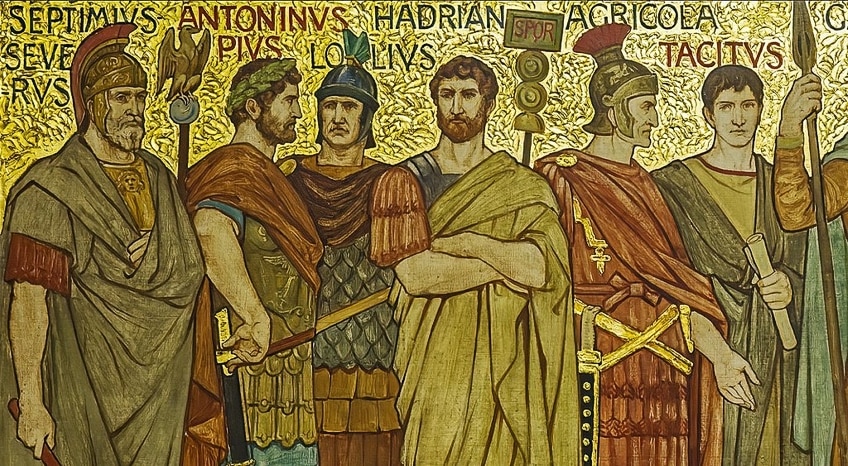 Roman generals and emperors closeup in the frieze of the Great Hall of the National Galleries Scotland by William Brassey Pigsty, 1897; William Brassey Pigsty, Public domain, via Wikimedia Commons
Roman generals and emperors closeup in the frieze of the Great Hall of the National Galleries Scotland by William Brassey Pigsty, 1897; William Brassey Pigsty, Public domain, via Wikimedia Commons
Fresco Painting Today
Fresco painting is certainly not every bit widespread today as it has been in the by, but some artists proceed to celebrate and explore the medium. The Making of a Fresco, an iconic fresco by Diego Rivera, a Mexican artist, is steeped with Marxist ethics. Rivera created a series of fresco murals around San Francisco Bay during the 1930s. The Making of a Fresco is a socialist commentary, with different levels of lodge represented by artists on a complicated scaffold.
The frescos past Italian-American creative person Francesco Clemente mix traditional techniques with contemporary ideas. The Avo Ovo painted by Clemente in Madrid in 2005 weaves together the artist's personal experiences and Neapolitan history.
Famous Frescos From Artifact and Modernity
The long and culturally diverse history of fresco painting has left us with many beautiful frescos, each emblematic of its fourth dimension. In the following section, nosotros are going to look more closely at some of the most famous fresco paintings of all fourth dimension. Nosotros begin with early frescos from Classical Antiquity and Sri Lanka and move onto some of the most famous frescos from the Loftier Renaissance catamenia.
1600-1450 BCE: Bull-Leaping Fresco
This fresco adorns the walls of the Knossos Palace in Crete. Despite the incredible historic period of this fresco, the colors remain vibrant and the composition complete. The fresco, painting some fourth dimension around 1400 BCE, depicts heavily stylized Grecian figures leaping over a bull. Individual men would perform acrobatic tricks as they lept over the backs of cows and bulls in this unique Minoan bull-leaping ritual. This fresco is one of the well-nigh famous works of art from the ancient Minoans, and its status is a testament to the durability of fresco painting techniques.
500-400 BCE: Sigiriya Rock Frescos
The western side of the Sigiriya Rock in Sri Lanka is adorned with a fresco painted during the 5th century BCE. King Kasyapa commissioned this series of frescos to transform his palace into an ethereal kingdom. The frescos depict 2 stylized women holding bowls of flowers. In that location has been much debate about who these women are, with many believing them to be heavenly nymphs showering mortals and kings with angelic gifts. Others believe these women to exist concubines and queens from the harem of King Kasyapa.
Whoever these women are, their dazzler remains vibrant today, protected from the weather by the rocky cavern around them. This fresco sits around 100 meters to a higher place the ground in a small cavern pocket. Whether they are celestial beings or not, these women have outlasted the society that created them.
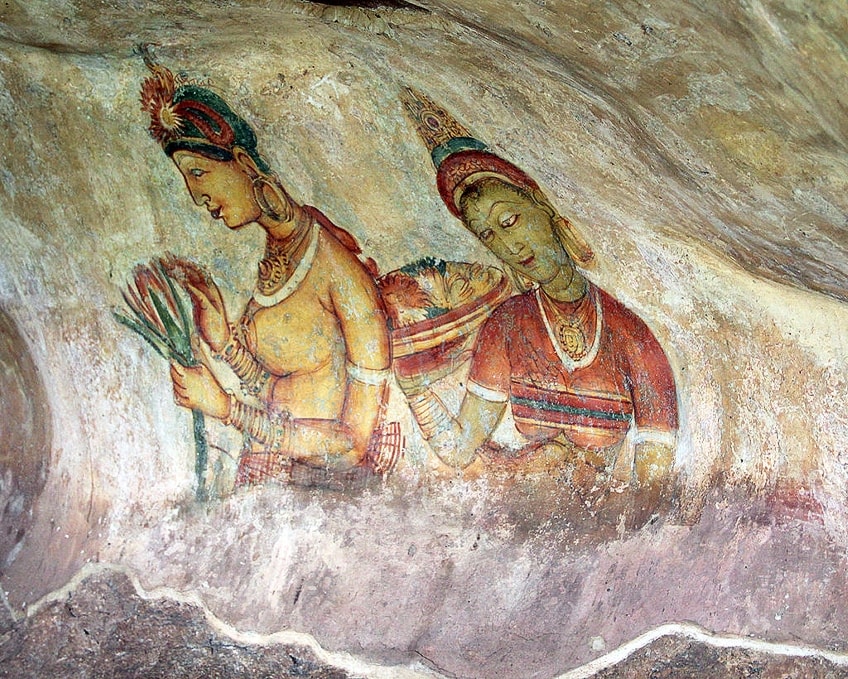 Sigiriya Rock Paintings #1 (500-400 BCE); Antony Stanley from Gloucester, UK, CC BY-SA 2.0, via Wikimedia Eatables
Sigiriya Rock Paintings #1 (500-400 BCE); Antony Stanley from Gloucester, UK, CC BY-SA 2.0, via Wikimedia Eatables
55-79 CE: Sappho Fresco
We have already spoken about the wealth of fresco murals discovered in Pompeii and this fresco painting, also known equally Woman with Wax Tablets and Stylus, is a beautifully preserved instance. This fresco is a wonderful example of the durability of Roman buon fresco. The Sappho Fresco survived the volcanic eruption, and information technology remains in very good condition.
The Sappho Fresco depicts a very wealthy young woman, dressed in luxurious robes, with gold thread in her pilus and big golden earrings. The woman is holding a stylus to her lips and a stack of wax tablets in her other manus. Although named after Sappho, the wax tablets, which are associated with accounting, bear no connection to the Greek poet.
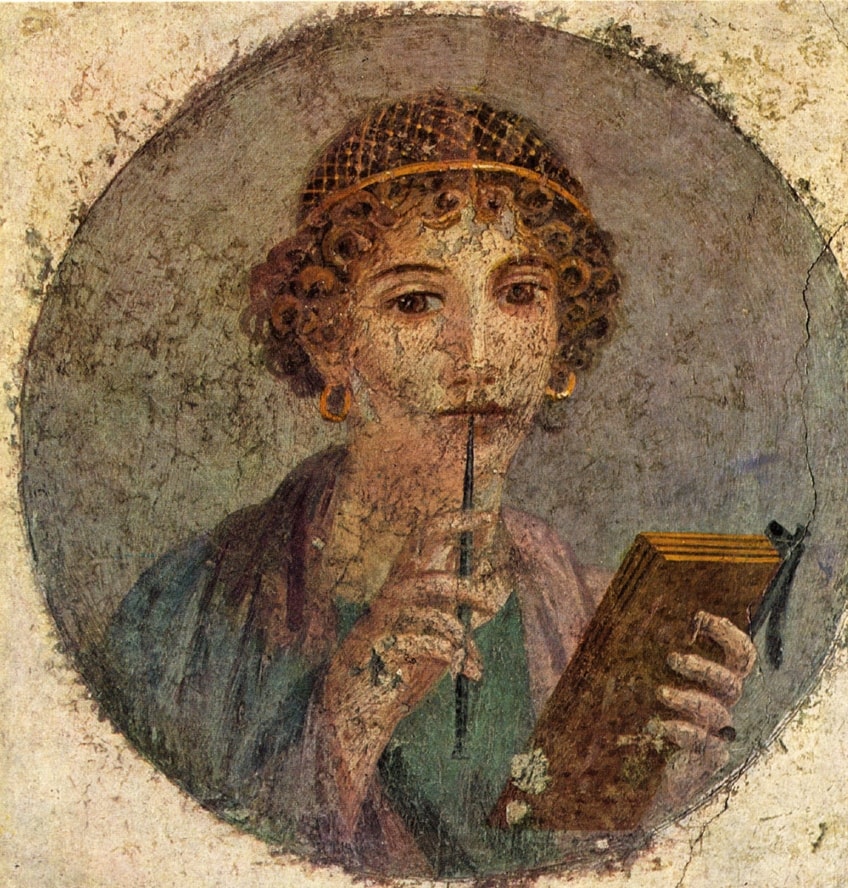 Woman with wax tablets and stylus (so-chosen"Sappho"), 55 to 79 Advertisement; Naples National Archaeological Museum, Public domain, via Wikimedia Commons
Woman with wax tablets and stylus (so-chosen"Sappho"), 55 to 79 Advertisement; Naples National Archaeological Museum, Public domain, via Wikimedia Commons
1442-1443 CE: The Annunciation
For many art historians, this fresco represents a transition from the Middle Ages to the fine art of the early Italian Renaissance. Painted by Italian Fra Angelico, The Proclamation has a more realistic composition than before medieval paintings. Much of the realism comes from the way that Angelico has captured a sense of depth by using a vanishing point.
A vanishing point is a perspective technique whereby the artists compose the slice along orthogonal lines that disappear at their meeting bespeak.
This fresco is not the first exploration of this religious iconography past Angelico, as he created another fresco and three similarly composed panel paintings. This fresco, which resides in the San Marco Convent in Florence, is one of the about famous early on Renaissance frescos.
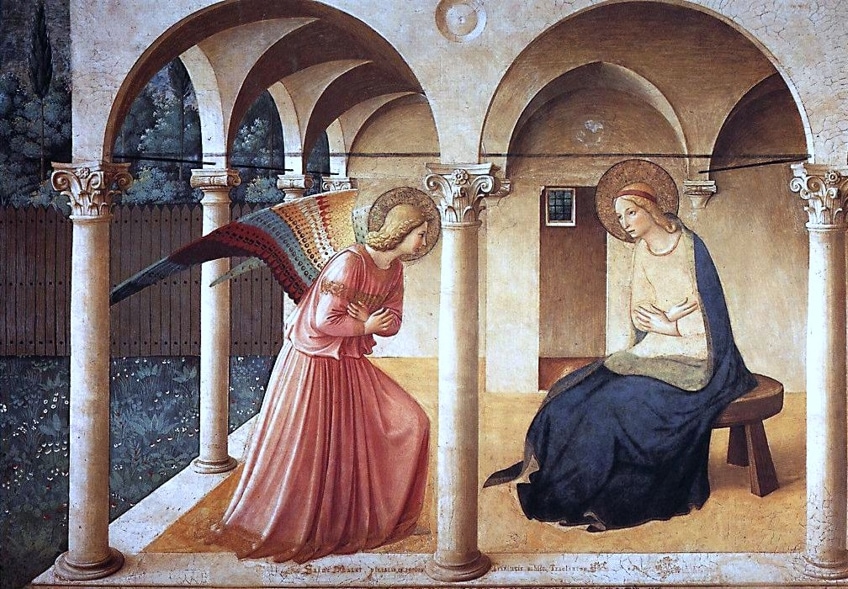 The Announcement (1437-1446) by Fra Angelico; Fra Angelico, CC By 2.0, via Wikimedia Commons
The Announcement (1437-1446) by Fra Angelico; Fra Angelico, CC By 2.0, via Wikimedia Commons
1495-1496: The Last Supper
This secco fresco is perhaps i of the about famous fresco paintings from the Italian Renaissance. The Convent of Santa Maria Delle Grazie commissioned da Vinci to paint this fresco depiction of Jesus' terminal meal with his disciples.
The Last Supper fresco is da Vinci's only surviving fresco and his largest painting. The spirit of exploration that characterizes da Vinci as the ultimate Renaissance man is evident in this deviation from traditional buon fresco. Leonardo da Vinci created this painting using a modified secco fresco technique.
On dry out plaster with a white pb undercoat, da Vinci painted with tempera paint and oil glazes to increase the color vibrancy. The use of tempera paint besides allowed da Vinci to recreate the blending he is known for and to brand adjustments to the composition.
Unfortunately, this experimental fashion was non well suited for plaster walls, and the fresco began to deteriorate during da Vinci's lifetime. The beautiful fresco we meet today has been restored several times, and non all of these restorations have been expert. Despite the degradation and somewhat sketchy restoration process, there are several features of da Vinci's composition that make this one of his greatest works.
The Last Supper uses a one-indicate perspective that da Vinci created with orthogonal lines that extend towards the back of the painting. The effect of this perspective is that the viewer sees the space within the fresco as if it were a continuation of the viewer's ain infinite.
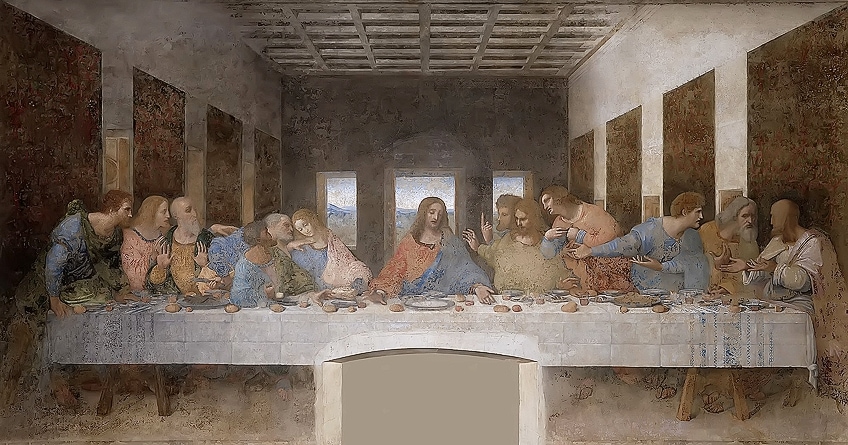 The Last Supper (1495-1496) by Leonardo da Vinci; Leonardo da Vinci, CC Past-SA four.0, via Wikimedia Commons
The Last Supper (1495-1496) by Leonardo da Vinci; Leonardo da Vinci, CC Past-SA four.0, via Wikimedia Commons
Leonardo da Vinci besides creates a light source on the left of the fresco that aligns with natural window lite inside the room. This lighting effect emphasizes the realism of this fresco. Finally, da Vinci creates a realistic humanism within this fresco by presenting the full range of emotionality on the disciples' faces as Jesus declares one of them volition betray him.
The Last Supper fresco by da Vinci is the first painting of the last supper to place the figure of Judas among the other disciples at the table. In earlier paintings, Judas was always depicted equally separate from the other disciples so the viewer could place him.
Leonardo da Vinci places him firmly among the other disciples, just he uses some clever compositional techniques to help the viewer detect Judas easily. For example, the effigy of Judas is shaded more darkly than the disciples around him, every bit da Vinci uses the symbolism of light and dark to highlight his moral character.
1508-1512: The Sistine Chapel Ceiling
This enormous buon fresco by Michelangelo is beyond all dubiety one of the virtually famous frescos ever created. The colorful and complex fresco spans the entirety of the Sistine Chapel ceiling. This buon fresco depicts nine essential biblical scenes and 343 separate figures. Michelangelo creates a sense of depth in this fresco past scraping out sections of the wet intonaco around many of these figures.
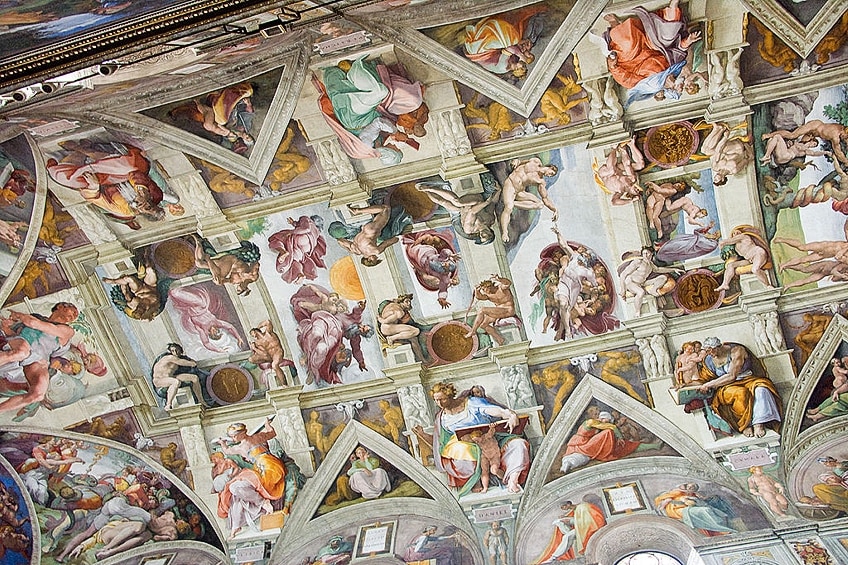 Ceiling of the Sistine Chapel by Michelangelo, 1508-1512, Vatican; Jean-Christophe BENOIST, CC By-SA iii.0, via Wikimedia Commons
Ceiling of the Sistine Chapel by Michelangelo, 1508-1512, Vatican; Jean-Christophe BENOIST, CC By-SA iii.0, via Wikimedia Commons
Michelangelo is said to have been apprehensive at showtime when he was asked to complete this fresco considering he saw himself primarily every bit a sculptor. Despite his doubts, he agreed to paint the ceiling of this Vatican chapel. Not only was the scale of this fresco ambitious, only the architectural features in the ceiling made this chore all the more than enervating. Large-scale scaffolding was erected, and Michelangelo and his administration began the painting piece of work.
Subsequently a while, Michelangelo dismissed his administration and finished the entire ceiling single-handedly. Michelangelo had to recoup for the distortion in his perspective created by the architecture and the curved ceiling. Michelangelo devised an illusionary architectural structure in the heart of the Sistine ceiling that framed the biblical scenes.
1511: The School of Athens
Our final famous fresco comes from the third not bad Renaissance painter, Raphael. This series of monumental frescos takes inspiration from the four primary schools of thought: law, theology, philosophy, and poetry. The School of Athens is the fresco celebrating aboriginal Greek philosophers through portraits of Euclid, Plato, Socrates, and Aristotle. Raphael even included a sneaky cocky-portrait in this fresco.
If y'all visit the Vatican you can find this fresco, and the other three on the Apostolic Palace walls. The other three frescos are named "Disputation of the Holy Sacrament", "Triumph of Galatia", and "Sistine Madonna".
All 4 frescos were completed within five years between 1509 and 1514, which is an impressively short time frame for such big-calibration frescos. Although Raphael was simply in his late twenties when he received the commission for these frescos, he did and then in competition with Michelangelo and da Vinci.
 Raphael's School of Athens, 1509–1511, fresco at the Raphael Rooms, Churchly Palace, Vatican City; Raphael, Public domain, via Wikimedia Commons
Raphael's School of Athens, 1509–1511, fresco at the Raphael Rooms, Churchly Palace, Vatican City; Raphael, Public domain, via Wikimedia Commons
Recommended Reading for Fresco Fanatics
What we have covered in this article is merely a brief history of the fresco medium. If you lot are interested in delving a fiddling deeper into the fascinating earth of frescos, nosotros can recommend the post-obit books.
Florence: The Paintings & Frescoes, 1250-1743
If you want the most comprehensive book about the frescos and paintings created in Florence, then this hardcover illustrated book past Ross King and Anja Grebe will stand you lot in good stead. This book includes over 2000 of the nigh beautiful artworks to come out of Florence between 1250 and 1743. The paintings include every work displayed at the Uffizi Gallery, the Accademia, the Duomo, and the Pitti Palace.

- The most comprehensive book on the paintings and frescos of Florence
- Over 2,000 beautifully reproduced artworks
- Includes every painted piece of work on display from selected galleries
View on Amazon
Italian Frescoes: Loftier Renaissance and Mannerism 1510-1600
This hardcover volume is the ultimate collection of 460 color-reproduced High Renaissance paintings and frescos, likewise as 60 plans and illustrations in black and white. The authors, Michael Rohlmann and Julian Kliemann, cover frescos with religious significance and secular imagery. This book is one of v volumes on Italian Frescos, and readers praise the high-quality images and informative text.
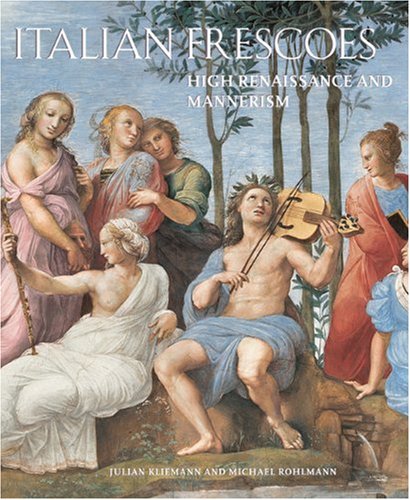
- Fourth book of Abbeville Press' survey of Italian fresco painting
- Historical and disquisitional overview of key works
- Fully illustrated with both detailed and wider, more contextual images
View on Amazon
Fresco painting techniques have been a fundamental characteristic of many cultural pieces of art throughout the ages. From the buon frescos of Classical Greek and Roman Antiquity to the vast frescos from some of the High Renaissance'south most celebrated artists, the fresco medium has ensured that the culture and history of our homo civilization have not been lost, completely. With pigment and plaster, we can grab a glimpse of what life was like and then long ago.
Take a expect at our fresco art webstory here!
Source: https://artincontext.org/fresco-painting/
0 Response to "Primary Type of Art Medium for Raphael the Artist"
Post a Comment